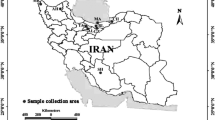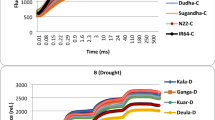Abstract
Asparagus officinalis is the most economically important species of asparagus worldwide. Commercial cultivars of asparagus are susceptible to some biotic and abiotic stresses. Drought stress is one of the most common stresses in agricultural crops cultivation. The main purpose of the current study was to compare Iranian asparagus accessions drought tolerance rate with that of ‘Mary Washington’ commercial cultivar and introducing superior accessions in terms of dry resistance rate. A factorial experiment was laid out based on a completely randomized design with three replications. The factors were a) asparagus accession in 10 levels including nine wild accessions of Iranian asparagus and ‘Mary Washington’ commercial cultivar (as control) and b) drought stress in four levels including 0 (as control), 5, 10 and 15% (w/v polyethylene glycol). Results showed that highest values of percentage and speed of seed germination and lengths of radicle and plumule were recorded in Gazanak accession. The lowest values of radicle length were recorded in Chalaki and Shiraz accessions (6.19 and 8.01 mm, respectively). Calli of ‘Mary Washington’ cultivar under highest applied level of drought stress showed the lowest value of relative growth rate (11.53 mg/day). Cluster analysis based on assessed characteristics under different applied levels of drought stress, divided Iranian asparagus accessions into four groups at Euclidean distance of 2.0. In conclusion, obtained results showed that Iranian asparagus accessions especially Gazanak accession could be a good candidate to apply in asparagus breeding programs with aim of producing asparagus dry tolerant cultivars.
Zusammenfassung
Asparagus officinalis ist die wirtschaftlich wichtigste Spargelart weltweit. Die im Handel erhältlichen Spargelsorten sind anfällig für einige biotische und abiotische Stressfaktoren. Trockenstress ist einer der häufigsten Stressfaktoren im landwirtschaftlichen Pflanzenanbau. Das Hauptziel der vorliegenden Studie bestand darin, die Trockentoleranz iranischer Spargelsorten mit der der kommerziellen Sorte ‘Mary Washington’ zu vergleichen und überlegene Sorten in Bezug auf die Trockenresistenz zu ermitteln. Es wurde ein faktorieller Versuch auf der Grundlage eines vollständig randomisierten Designs mit drei Wiederholungen angelegt. Die Faktoren waren a) Spargelsorten in 10 Stufen, darunter neun Wildsorten iranischen Spargels und die kommerzielle Sorte ‘Mary Washington’ (als Kontrolle) und b) Trockenstress in vier Stufen, darunter 0 (als Kontrolle), 5, 10 und 15 % (w/v Polyethylenglykol). Die Ergebnisse zeigten, dass die höchsten Werte für den prozentualen Anteil und die Geschwindigkeit der Samenkeimung sowie für die Länge der Keimwurzel und der Knospe bei der Sorte ‘Gazanak’ verzeichnet wurden. Die niedrigsten Werte für die Länge der Keimwurzel wurden bei den Sorten ‘Chalaki’ und ‘Shiraz’ festgestellt (6,19 bzw. 8,01 mm). Die Kalli der Sorte ‘Mary Washington’ zeigten unter dem höchsten angewandten Trockenstress den niedrigsten Wert der relativen Wachstumsrate (11,53 mg/Tag). Eine Clusteranalyse auf der Grundlage der bewerteten Merkmale unter verschiedenen Trockenstressniveaus teilte die iranischen Spargelsorten in vier Gruppen mit einem euklidischen Abstand von 2,0. Die Ergebnisse zeigen, dass iranische Spargelsorten, insbesondere die Sorte ‘Gazanak’, ein guter Kandidat für Spargelzuchtprogramme sein könnten, um trockenheitstolerante Spargelsorten zu züchten.




Similar content being viewed by others
References
Amian L, Rubio J, Castro P, Gil J, Moreno R (2018) Introgression of wild relative asparagus spp. germplasm into the Spanish landrace ‘Morado de Huetor’. XIVth international asparagus symposium. Acta Hortic 1223:33–38
Arnon AN (1967) Method of extraction of chlorophyll in the plants. Agron J 23:112–121
Bansal RK, Menzies SA, Broadhurst PG (1986) Screening of Asparagus species for resistance to Stemphylium leaf spot. NZ J Agric Res 29:539–545
Bidabadi SS, Mehralian MS (2020) Bio-priming to improve germination, seedling growth and essential oil yield of Dracocephalum Kotschyi Boiss, an endangered medicinal plant in Iran. Gesunde Pflanz 72:17–27. https://doi.org/10.1007/s10343-019-00478-2
Chandra A, Dubey A (2010) Effect of ploidy levels on the activities of Δ1-pyrroline-5-carboxylate synthetase, superoxide dismutase and peroxidase in Cenchrus species grown under water stress. Plant Physiol Biochem 48:27–34
Drost D, Wilcox-Lee D (1997) Soil water deficits and asparagus: I. Shoot, root, and bud growth during two seasons. Sci Hortic 70:131–143
Fan HF, Ding L, Du CX, Wu X (2014) Effect of short-term water deficit stress on antioxidative systems in cucumber seedling roots. Bot Stud 55:46. https://doi.org/10.1186/s40529-014-0046-6
Fladung M (2018) Growth of Mixoploid gibberellic acid 20 oxidase (GA20-OXIDASE) overexpressing transgenic Populus. Gesunde Pflanz 70:91–98. https://doi.org/10.1007/s10343-018-0418-z
Förster N, Mewis I, Ulrichs C (2013) Moringa Oleifera—establishment and multiplication of different ecotypes in vitro. Gesunde Pflanz 65:21–31. https://doi.org/10.1007/s10343-013-0291-8
Ghahremani Z, Mikaealzadeh M, Barzegar T, Ranjabr ME (2021a) Foliar application of ascorbic acid and gamma aminobutyric acid can improve important properties of deficit irrigated cucumber plants (Cucumis sativus cv. Us). Gesunde Pflanz 73:77–84. https://doi.org/10.1007/s10343-020-00530-6
Ghahremani Z, Norouzi M, Barzegar T, Ranjbar ME (2021b) Calcium lactate and salicylic acid foliar application influence eggplant growth and postharvest quality parameters. Acta Agric Slov 117(2):1–10
Goßmann M, Kleta S, Humpf HU, Büttner C (2005) Untersuchungen zum endophytischen Befall von Fusarium proliferatum (Matsushima) Nirenberg in geernteten Stangen von Spargel (Asparagus officinalis L.). Gesunde Pflanz 57:53–58. https://doi.org/10.1007/s10343-005-0065-z
Hamdi SMM, Assadi M (2017) Asparagus azerbaijanensis, a new species of Asparagus subgen. Asparagopsis (Asparagaceae) from Iran. Phytotaxa 297(1):93–96
Khan SH, Khan A, Litaf U, Shah AS, Khan MA, Bilal M, Ali MU (2015) Effect of drought stress on tomato cv. Bombino. J Food Process Technol 6:465. https://doi.org/10.4172/2157-7110.1000465
Mousavizadeh SJ, Gil J, Castro P, Hassandokht MR, Moreno R (2021a) Genetic diversity and phylogenetic analysis in Asian and European Asparagus subgenus species. Genet Resour Crop Evol. https://doi.org/10.1007/s10722-021-01262-w
Mousavizadeh SJ, Gil J, Moreno R, Mashayekhi K (2021b) Asparagus ploidy distribution related to climates adaptation in Iran. Environ Dev Sustain. https://doi.org/10.1007/s10668-021-01672-x
Mousavizadeh SJ, Hassandokht MR, Kashi A (2015) Multivariate analysis of edible asparagus species in Iran by morphological characters. Euphytica 206:445–457
Mousavizadeh SJ, Hassandokht MR, Kashi A (2017) In vitro response of Asparagus breslerianus to NaCl. J Med Plant Byprod 2:153–163
Murashige T, Skoog F (1962) A revised medium for rapid growth and bio assays with tobacco tissue cultures. Plant Physiol 15:473–497
Nadali F, Asghari HR, Abbasdokht H, Dorostkar V (2021) Improved quinoa growth, physiological response, and yield by hydropriming under drought stress conditions. Gesunde Pflanz 73:53–66. https://doi.org/10.1007/s10343-020-00527-1
Rahimi S, Hatami M, Ghorbanpour M (2021) Silicon-nanoparticle mediated changes in seed germination and vigor index of marigold (Calendula officinalis L.) compared to silicate under PEG-induced drought stress. Gesunde Pflanz. https://doi.org/10.1007/s10343-021-00579-x
Sarabi B, Hassandokht MR, EsmailHassani M, RamakMasoumi T, Rich T (2010) Evaluation of genetic diversity among some Iranian wild asparagus populations using morphological characteristics and RAPD markers. Sci Hortic 126(1):1–7
Sun YL, Hong SK (2010) Effects of plant growth regulators and L‑glutamic acid on shoot organogenesis in thehalophyte Leymus chinensis (Trin.). Plant Cell Tiss Organ Cult 100:317–328
Wang JY, Turner NC, Liu YX, Siddique KHM, Xiong YC (2017) Effects of drought stress on morphological, physiologicaland biochemical characteristics of wheat species differing in ploidy level. Funct Plant Biol 44:219–234
Widaryanto E, Puji Wicaksono K, Najiyah H (2017) Drought effect simulation on the growth and yield quality of melon (Cucumis melo L.). J Agron 16:147–153. https://doi.org/10.3923/ja.2017.147.153
Funding
This work was supported by university of Zanjan (grant number 99.06.348).
Author information
Authors and Affiliations
Corresponding author
Ethics declarations
Conflict of interest
A. Namaki, Z. Ghahremani, M. Aelaei, T. Barzegar and M.E. Ranjbar declare that they have no competing interests.
Rights and permissions
About this article
Cite this article
Namaki, A., Ghahremani, Z., Aelaei, M. et al. The First Report of Drought Tolerance Assessment of Iranian Asparagus. Gesunde Pflanzen 74, 141–149 (2022). https://doi.org/10.1007/s10343-021-00596-w
Received:
Accepted:
Published:
Issue Date:
DOI: https://doi.org/10.1007/s10343-021-00596-w




